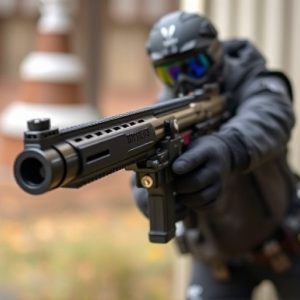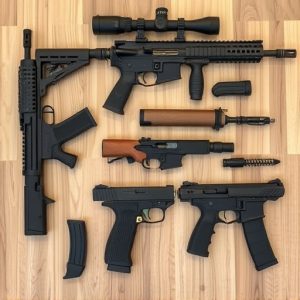Exploring Effective Non-Lethal Home Defense Weapons
Non-lethal home defense weapons offer a safe and effective means to protect your home and family. T…….
Non-lethal home defense weapons offer a safe and effective means to protect your home and family. These include pepper spray, stun guns, personal alarms, tactical flashlights, and mace, each with unique capabilities to deter intruders and ensure personal safety without causing permanent harm. Pepper spray and mace use a highly concentrated capsaicin formula to temporarily disable an attacker by causing severe irritation, providing a quick escape or time to call for help. Stun guns and Tasers deliver a high-voltage electric shock that immobilizes an intruder, disrupting their attack and allowing for a safe retreat. Personal alarms sound a loud alarm to scare off intruders and alert neighbors or law enforcement, ensuring a prompt response. Tactical flashlights offer visibility and can temporarily blind an assailant, while also having settings that cause sensory overload. These non-lethal options must be used responsibly and within legal guidelines, with proper training and maintenance to ensure they function correctly in critical moments. Integrating these tools into your home defense strategy provides a humane yet effective way to enhance security without resorting to lethal force.
When securing one’s sanctuary, non-lethal home defense weapons emerge as a prudent choice for safety and peace of mind. This article illuminates the various non-lethal options available for homeowners, including the potency of pepper spray and mace, the role of stun guns and tasers in personal protection, and the utility of tactical flashlights coupled with personal alarms as deterrents through light and sound. We will also delve into the best practices and legal implications of employing these tools. Understanding their effectiveness in home defense scenarios is paramount for informed decision-making in safeguarding your living space.
Understanding Non-Lethal Home Defense Options
When securing one’s home against potential threats, it is imperative to consider non-lethal home defense weapons as a first line of defense. These alternatives offer a means to deter intruders and protect personal safety without causing permanent harm or fatal injuries. Non-lethal options include a variety of devices such as pepper spray, stun guns, and personal alarms. Pepper sprays are highly effective due to their incapacitating effects, which can be more than sufficient to thwart an attacker’s advance. Stun guns deliver a high-voltage electric shock that temporarily immobilizes an individual, providing valuable escape time. Personal alarms, on the other hand, can alert neighbors or law enforcement to the disturbance, potentially deterring criminals and drawing assistance quickly.
Selecting appropriate non-lethal home defense weapons involves understanding the legal implications, effectiveness, and ease of use in various scenarios. It is crucial to familiarize oneself with state and local laws regarding self-defense tools to ensure compliance. Additionally, considering the specific circumstances under which these devices may be used—such as the presence of children or pets—is essential for responsible ownership. Training and proper maintenance are also critical factors to ensure these weapons function optimally when they are most needed. By carefully selecting and employing non-lethal defense mechanisms, homeowners can enhance their safety while minimizing the risk of escalation to more serious confrontations.
Pepper Spray and Mace: Effective Deterrents for Intruders
Non lethal home defense weapons such as pepper spray and mace represent effective deterrents against intruders, offering a balanced line of defense between safety and serious injury. Pepper spray, also known as OC (oleoresin capsicum) spray, is a powerful self-defense tool that can incapacitate an assailant quickly and effectively. It uses a highly concentrated formula of capsaicin, the active component found in chili peppers, to cause intense irritation upon contact with the eyes, skin, and respiratory tract. The effects are temporary but profound, often leading to a state where an intruder is incapable of continuing their threat, allowing occupants to escape or call for help. Mace, another form of non lethal spray, delivers a similar range of effects, with variations in formulation and concentration. Both pepper spray and mace are user-friendly; they are easy to operate, have a long shelf life, and can be stored without the need for complex maintenance or training. Their compact size makes them ideal for home defense strategies, ensuring that they can be deployed swiftly and accurately during an intrusion. In the event of an emergency, these non lethal home defense weapons provide a decisive yet humane response to protect one’s property and family without causing long-term harm or resorting to lethal force.
Stun Guns and Tasers: Electric Shock Defenses for Personal Security
Non-lethal home defense weapons like stun guns and Tasers offer a viable alternative for individuals seeking to protect their homes and themselves without resorting to firearms or lethal force. Stun guns and Tasers operate on the principle of delivering an electric shock to incapacitate an intruder, effectively halting their advance. These devices use high-voltage, low-ampereage electrical currents to overstimulate the muscles, causing involuntary muscle contractions that can render an attacker immobile for several minutes. The effectiveness of these devices is rooted in their ability to neutralize a threat without causing permanent harm or death.
When integrated into a home defense strategy, stun guns and Tasers serve as deterrents that can be employed with precision during an encounter. They are often compact and portable, allowing for easy storage and accessibility. Users typically have the option of shock probes or electrode cartridges that deliver the electrical charge at a safe distance, which is crucial in unpredictable situations. It’s important to familiarize oneself with the proper use and legal considerations associated with these non-lethal home defense weapons to ensure their effective and lawful deployment in the event of an intrusion.
Tactical Flashlights and Personal Alarms: Light and Sound as Deterrents
When considering non-lethal home defense weapons, tactical flashlights and personal alarms emerge as effective deterrents that combine light and sound to enhance safety. Tactical flashlights are versatile tools for home security, serving not only to illuminate dark spaces during unexpected intrusions but also to disorient an intruder temporarily. Their high-intensity beams can cause temporary blindness, providing a critical moment for escape or to alert authorities. These flashlights often feature multiple settings, including strobe and SOS modes, which can further incapacitate an attacker by inducing sensory overload.
Personal alarms, on the other hand, are audible warning devices that can be deployed quickly and effectively. They emit a piercing sound, often at decibel levels that are discomforting yet safe for humans over short durations. The suddenness and volume of the alarm can be startling to an intruder, deterring them from proceeding further into the home. These alarms are typically easy to carry and activate, with models designed to fit on keychains or wearable items. When integrated into a comprehensive home security strategy alongside other non-lethal defense weapons like pepper spray or stun guns, tactical flashlights and personal alarms can significantly increase one’s ability to protect their home and family without resorting to lethal force.


